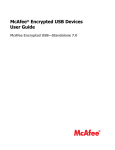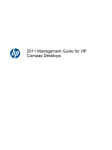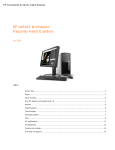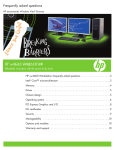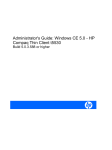Download HP NF759LA Point of Sale
Transcript
Administrator Guide HP Backup and Recovery Manager © Copyright 2007 Hewlett-Packard Development Company, L.P. The information contained herein is subject to change without notice. Microsoft and Windows are trademarks of Microsoft Corporation in the U.S. and other countries. The only warranties for HP products and services are set forth in the express warranty statements accompanying such products and services. Nothing herein should be construed as constituting an additional warranty. HP shall not be liable for technical or editorial errors or omissions contained herein. This document contains proprietary information that is protected by copyright. No part of this document may be photocopied, reproduced, or translated to another language without the prior written consent of Hewlett-Packard Company. Administrator Guide Business PCs First Edition (February 2007) Document Part Number: 440208–001 About This Book WARNING! Text set off in this manner indicates that failure to follow directions could result in bodily harm or loss of life. CAUTION: Text set off in this manner indicates that failure to follow directions could result in damage to equipment or loss of information. NOTE: Text set off in this manner provides important supplemental information. ENWW iii iv About This Book ENWW Table of contents HP Backup and Recovery Manager Administrator Guide Versions of HP Backup and Recovery Manager ............................................................................ 2 Portables .................................................................................................................. 2 Desktops .................................................................................................................. 2 Backup types ........................................................................................................................... 3 Recovery Points ......................................................................................................... 3 Entire Drive Backups .................................................................................................. 3 File and data backups ............................................................................................... 4 Notes about the different backup types ........................................................................ 4 Differences between versions ..................................................................................................... 5 Installation ............................................................................................................................... 6 Software options ....................................................................................................... 6 Getting the software for an image ............................................................................... 6 Deploying in an enterprise environment ....................................................................... 6 Deploying a single version of the software across different models of systems ................... 7 Installing on multiple partitions .................................................................................... 7 Reimaging a hard drive ............................................................................................. 7 Managing HP Backup and Recovery Manager ............................................................................ 8 Enforcing policies/scheduling ..................................................................................... 8 Passwords ................................................................................................................ 9 Compression .......................................................................................................... 10 Encryption .............................................................................................................. 10 Integrated F11 hotkey support .................................................................................. 10 Enabling/disabling features ..................................................................................... 10 Master Boot Record (MBR) reset after reloading custom operating system ....................... 10 Reminders ............................................................................................................................. 11 Basic reminder functionality ...................................................................................... 11 Disabling the reminder message ............................................................................... 11 Backups ................................................................................................................................ 12 Offline backups ...................................................................................................... 12 Sector or file-based backups ..................................................................................... 12 Integrity validation .................................................................................................. 12 Backups and RAID support ....................................................................................... 12 Backup option storage location ................................................................................. 12 Bandwidth limiting .................................................................................................. 13 Backup failover ....................................................................................................... 13 Entire Drive Backup on local drive ............................................................................. 13 Scheduled backups ................................................................................................. 13 Manual backups ..................................................................................................... 13 ENWW v Recovery Points ........................................................................................ 14 Saving components .................................................................................. 14 Recovery ............................................................................................................................... 14 Recovery Partition ................................................................................................... 14 Recovery Media Creator .......................................................................................... 15 Operating system .................................................................................................... 15 Recovery media ...................................................................................................... 15 How to recover ....................................................................................................... 16 Recovery media creation .......................................................................................... 17 Removing the Recovery Partition ................................................................................ 17 PC Recovery ........................................................................................................... 18 Restoring an entire image or individual files ............................................................... 19 Recovering individual files ......................................................................... 21 PC recovery ............................................................................................. 25 Restoration and name duplication ............................................................................. 29 Operating system PID .............................................................................................. 29 File explorer for recovering files ................................................................................ 29 Filter in both directions ............................................................................................. 29 Uninstallation ........................................................................................................................ 29 What is removed? ................................................................................................... 29 Uninstalling the application ...................................................................................... 29 Expert options ........................................................................................................................ 30 Index ................................................................................................................................. 31 vi ENWW HP Backup and Recovery Manager Administrator Guide NOTE: This document provides information about the full version HP Backup and Recovery Manager. Not all functions and features are available in the limited version of the software. The HP Backup and Recovery Manager is a highly versatile application that works within Windows to create backups of the operating system, all applications, and all data files. The application allows you to back up and recover the primary hard drive on the PC. With Backup and Recovery Manager you can: ENWW ● Schedule backups to occur automatically at designated intervals. ● Manually initiate backups. ● Archive important files separately from regular backups. ● Copy Recovery Points and File Backups to CD or DVD. ● Copy all to network or secondary hard disks. ● Copy to external USB devices (disk-on key or external USB hard drives). 1 For more information about HP Backup and Recovery Manager, see the HP Backup and Recovery Manager Datasheet at http://h20331.www2.hp.com/Hpsub/downloads/ HP_Backup_and_recovery_Manager.pdf. Versions of HP Backup and Recovery Manager There are two different versions of HP Backup and Recovery Manager ● Portables ● Desktops NOTE: Portables offers a separate Rescue CD that you can use to restore your computer. You can also create Recovery CDs on Portables. Desktops does not currently offer a Rescue CD — you to create your own Recovery CD set. NOTE: For Portables, there is an update to version 2.3G that you must obtain from a Softpaq. Search www.hp.com for this update. Portables To locate HP Backup and Recovery Manager on Portables, note that there are two folders with HP Backup and Recovery Manager files — C:\SWSETUP\SFT and C:\SWSETUP\SFT_REC. The SFT_REC version expands on the hard drive to almost the same contents as SFT, and a link is placed on the desktop to allow a user to install it. The SFT version has an extra directory and files, which are used only in the factory image. The Portable version of Backup and Recovery Manager also includes a component that allows you to back up to the HP 3-in-1 NAS Docking Station. Desktops When you create Recovery Media, you can also create ISO files versus directly creating a CD/DVD with HP Backup and Recovery Manager. If you want to go through the back door to get the ISO file, then 2 HP Backup and Recovery Manager Administrator Guide ENWW navigate to the ISO’s directory in the Backup and Recovery partition (e.g. D:\ISOS) and locate the HP Backup and Recovery ISO file. To explore the Recovery Partition, in the command window type regsvr32 shellvrtf.dll /u. NOTE: For Portables, no pre-existing ISO files are present. You must have HP Backup and Recovery Manager create the ISO files. Backup types HP Backup and Recovery Manager offers more options than typical backup software, including: ● Recovery Points ● Entire Drive Backups ● File and data backups Desktops and Portables allow backing up from the following: ● Desktop—You can backup from recommended locations. ● Portables—You can perform advanced backups from specific locations. For detailed instructions about performing the various types of backups, see Restoring an entire image or individual files on page 19 Recovery Points Recovery Points are point in time backups that incrementally back up the computer. The Initial Recovery Point is a large backup of the entire system, known as the Restore Image. The Initial Recovery Point is created automatically. All subsequent Recovery Points capture only new user data created since the previous Recovery Point. The Initial Recovery Point backup is large and takes longer to perform as it contains the initial base image; however, subsequent incremental Recovery Point backups can be small enough to fit on a CD, depending on the size of data backed up. You can use a Recovery Point to restore a system to a blank hard drive. For Portables, use the Rescue CD or the first disc of the Recovery Media Creator set or the Recovery Partition to restore a system image using a Recovery Point. For Desktops, this procedure requires the Recovery Partition. You can restore a system with the Recovery Media Creator set, and then restore the Recovery Point. For more information about recovery and restoration, see Restoring an entire image or individual files on page 19. NOTE: Once you finish the media creation process, you cannot use HP Backup and Recovery Manager to create additional copies of the Initial Recovery Point. Entire Drive Backups Entire Drive Backups allow you to backup the entire system, including Windows partition data. Entire Drive Backups do not include the Recovery Partition. Since the Entire Drive Backup backs up the Windows partition, this type of backup is more of a low maintenance backup where space is not a concern (i.e., backup to a network share or an external USB hard drive). Entire Drive Backups can take longer to execute than Recovery Points, depending on the size of the Windows partition. ENWW Backup types 3 NOTE: You do not need to restore the Initial Recovery Point before using an incremental Recovery Point or Entire Drive Backup to restore a system. NOTE: You cannot recover individual files or folders from Recovery Points or Entire Drive Backups. You can only recover individual files and folders if you perform the backup using the individual file and folder backup functionality. File and data backups You can perform backups of individual files and folders. File backups allow you to back up specific files without having to recreate lengthy Recovery Points or Entire Drive Backups. You can also specify file type backups. For example, you can set HP Backup and Recovery Manager to back up all .doc files. Notes about the different backup types You can use previously-created Recovery Points or Entire Drive Backups to restore a system to a blank hard drive; however, the procedure between Portables and Desktops differs. For Portables, you can use the Rescue CD to perform this function. For Desktops, you must recover the system using the Recovery Media Creator, and then restore the Recovery Point or Entire Drive Backup. You can place any of the backup types onto media (CD, DVD). The only limitation is file size. For example, you can save a Recovery Point to CD, as long as the file size is smaller than the amount of room available on the CD (typically 700MB on a blank CD). You can save larger backups that do not fit onto media to network drives. You cannot create a “recovery media” from the “File and folder backups” category. This means that while you can restore individual files and folders, you cannot restore an image onto a blank hard drive using individual files and folder backups. In HP Backup and Recovery Manager, you can only explore individual backup files saved using the Back up individual files and folders option. You cannot restore individual files from Recovery Points or Entire Drive Backups. Backup and Recovery Manager utilizes Windows PE (Windows Pre-Installation Environment) to restore backups. 4 HP Backup and Recovery Manager Administrator Guide ENWW Differences between versions The following table provides differences between the different versions of HP Backup and Recovery Manager. Software Component Desktops Portables Rescue CD Currently no Rescue CD. You must create your own recovery CDs. Included Rescue CD to use if you remove the Recovery Partition during installation of HP Backup and Recovery Manager. Rescue CD allows you to restore Entire Drive Backups, Recovery Points, or file/ folder backups. If you installed HP Backup and Recovery Manager in a de-featured mode (no Recovery Partition), then you cannot create Recovery Points. SafeBoot support No. Under consideration for future release. Yes Quad byte support (specific Asian languages) Yes No Scheduling Advanced File Backup Supported. User can select what type of backup, time, and where to store it. Advanced file backup scheduling but no recommended locations. Installation Unattended installation capability. For end user installation, option available to install creating or not creating Recovery Partition. SafeBoot encryption provides encryption prevents intrusions to a hard drive when the machine is in use. Creating a Recovery Partition: Full functional HP Backup and Recovery Manager. Not creating Recovery Point: Only backup/restore of files/folders, Entire Drive Backup, and scheduling. ENWW Encryption Files backed up with native MS Encryption (EFS). You can encrypt, and a password protects the backup archive using. You can only decrypt the files on the same Windows installation with the same administrator credentials/ account. Files backed up “decrypted”. You must select encryption and/or password protection to secure backup archive using ST encryption method. You can restore those files to any Windows installation. HP 3-in-1 NAS Docking Station support in folder menus No Yes Differences between versions 5 Installation HP Backup and Recovery Manager is preinstalled on both Desktop and Portable computers. Additionally, on Portable computers, an end-user installation version is located in the C:\SWSETUP\SFT_REC folder. NOTE: There are two folders with HP Backup and Recovery Manager files — C:\SWSETUP\SFT and C:\SWSETUP\SFT_REC. The SFT_REC version expands on the hard drive to almost the same contents as SFT, and a link is placed on the desktop to allow a user to install it. The SFT version has an extra directory and files, which are used only in the factory image. NOTE: Desktops uses a COMPAQ folder instead of a SWSETUP folder on Windows XP. Software options The HP Backup and Recovery Manager is available in two forms: ● Shipped preinstalled on the computer ● On the Supplemental CD with Workstations and Desktops, and in the C:\SWSETUP\SFT_REC folder on Portables. You can burn the C:\SWSETUP\SFT_REC folder to CD and run the .exe from the CD to install. When preinstalled on the computer, HP Backup and Recovery Manager is automatically part of the Recovery Partition, and when created, the Recovery Disc Set. This application is already resident on the computer and is automatically deployed again when the system is recovered. When included as part of an HP hardware purchase, the HP Backup and Recovery Manager is easily installed by running the setup.exe application from the CD. HP provides upgraded versions of the Backup and Recovery Manager software on the Web for Portables. The upgrade is in the same download location as drivers and other bundled software updates. For Portables, the software is preinstalled. Run the setup.exe file from the C:\SWSETUP\SFT_REC folder. Getting the software for an image If you want to use your own custom image, select the software you want from the C:\SWSETUP folder. Alternately, for Desktops you can burn the ISO images that are available on the Recovery Partition, load a clean operating system, and choose which software offerings you want to install. NOTE: HP Backup and Recovery Manager is available only on systems on which it came preinstalled. Systems that did not come with the HP Backup and Recovery Manager preinstalled are not licensed to use the software. Deploying in an enterprise environment You can deploy HP Backup and Recovery Manager in an enterprise environment using the following options: 6 ● Desktops—You can install HP Backup and Recovery Manager and create a backup in an unattended fashion using the command SETUP.EXE –S –Q ● Portables—Automated installations are not supported; therefore, HP Backup and Recovery Manager must be preloaded, with interactive installation per system thereafter. HP Backup and Recovery Manager Administrator Guide ENWW Deploying a single version of the software across different models of systems A single version of HP Backup and Recovery Manager supports many different models/systems; therefore, you can install a single version on any supported system. Installing on multiple partitions Installing Backup and Recovery Manager on a drive with multiple partitions is supported for Desktops, but not supported for Portables. However, you can add partitions after installing Backup and Recovery Manager. The following workaround may allow you to install the application: 1. Reformat a 75-GB disk. 2. Use RDEPLOY to create a 50-GB C partition and lay down the Factory/Gold unbooted image that contains v2.3i. 3. Using WinPE, use DISKPART to create an empty 20-GB D partition. 4. Allow the factory image to completely install HP Backup and Recovery Manager and all associated software. Reimaging a hard drive HP Backup and Recovery Manager supports installation on multiple partitions in Desktops. It does not support installing with multiple partitions for Portables. You can add additional partitions and disks after installation. After laying down an image on a previously-imaged system with HP Backup and Recovery Manager, DISKPART running from WinPE may not “unlock” or “clean” the hard drive so you can re-image it. In this situation, WinPE creates a PAGEFILE.SYS on the hard drive due to the WINBOM.INI in the HP Backup and Recovery partition. DISKPART cannot alter the C partition when WinPE accesses it. To re-image the hard drive in this instance, either: ● Edit the WinPE build to prevent using the WINBOM.INI in the HP Backup and Recovery partition or ● Remove WINBOM.INI from the HP Backup and Recovery partition. 1. Rebuild the WinPE CD image so the registry points to a known good WINBOM.INI. The path and file name specified by the registry key is: HKEY_LOCAL_MACHINE\SOFTWARE\Microsoft\Factory \Winbom. NOTE: In general, WinPE might pick up other WINBOM.INI files elsewhere in the system. To make sure you are using the correct WINBOM.INI file, use the registry setting. 2. Rename or delete WINBOM.INI in the HP Backup and Recovery partition, and then reboot WinPE. In the case of reimaging, deleting the WINBOM.INI file is an option, but if you do this when you do not want to re-image, HP Backup and Recovery will not work after WINBOM.INI is deleted. ENWW Installation 7 The workaround involves renaming all the WINBOM.INI files (other than on the X:\ drive since WinPE boots to X:\) before running FACTORY.EXE, and then renaming all the other WINBOM.INI files back after FACTORY.EXE is finished as shown below. Please note that if something goes wrong before WINBOM.INI files are renamed to their original name, other utilities like HP Backup and Recovery Manager will not work. for %%a in (a,b,c,d,e,f,g,h,i,j,k,l,m,n,o,p,q,r,s,t,u,v,w,y,z) DO if exist %%a:\winbom.ini ren %%a:\winbom.ini winbom.tmp factory –winpe for %%a in (a,b,c,d,e,f,g,h,i,j,k,l,m,n,o,p,q,r,s,t,u,v,w,y,z) DO if exist %%a:\winbom.ini ren %%a:\winbom.tmp winbom.ini For performance reasons, the WINBOM.INI in HP Backup and Recovery Manager has the PageFileSize=64 line that creates the PAGEFILE.SYS on C:. NOTE: After re-imaging a machine and then attempting to install Backup and Recovery Manager, an computer may not be bootable and may have a blinking cursor on the upper left hand corner. If this occurs, ensure MBR reset when you laid down the operating system image. Managing HP Backup and Recovery Manager The following sections provide information about management of Backup and Recovery Manager. NOTE: You cannot manage HP Backup and Recovery Manager using Microsoft Windows Management Instrumentation (WMI). Enforcing policies/scheduling The HP Backup and Recovery Manager provides a scheduling utility that after configured, requires no user intervention. HP recommends that the backup schedule be created immediately to ensure continued system and data security. 8 HP Backup and Recovery Manager Administrator Guide ENWW Scheduling is the same for both Desktops and Portables for the following backup types: ● Entire Drive Backup ● Recovery Point Manager ● File and Folder Backup NOTE: You can schedule to an external drive, network, or HP 3-in-1 NAS (Portables only). NOTE: You cannot schedule Recovery Media Creator, as it is a one time operation. There is a weekly reminder that you can indicate to ignore, remind the user later, or never remind again. After fourth time the reminder displays, it will automatically not display again. NOTE: You can perform scheduling only on the local system. NOTE: There is currently no functionality that allows an Administrator to force users to perform backups. Passwords HP Backup and Recovery Manager offers password protection. Passwords protect Entire Drive Backups as well as individual file backups. Passwords are independent of users or systems. NOTE: There is no password protection for Recovery Points. You can password protect an initial Entire Drive Backup; however, because the Initial Recovery Point contains little user data, and passwords are meant to protect sensitive data, the Initial Recovery Point and incremental Recovery Points together are not password protected. ENWW Managing HP Backup and Recovery Manager 9 Compression HP Backup and Recovery Manager uses compression. The compression ratio depends on the data on the disk and can range between 30% and 70%. Encryption You can encrypt “individual file and folder” backups. You can password protect backup types. The encryption algorithm is a simple encode based on logical XORs and bit rotations. Only HP Backup and Recovery Manager can read the encryption. NOTE: The backup should not be considered as “protected” since no password/key is involved. When backing up encrypted files in an EFS file system, the files backed up remain encrypted. Backup and Recovery Manager will recover ProtectTools encrypted files. Note that you can only recover encrypted files on the system where they were created unless the Embedded Security credential data is migrated to the new system where the files will be recovered. Information on migrating Embedded Security credential data is provided in the ProtectTools help files. Integrated F11 hotkey support HP Backup and Recovery Manager supports the integrated F11 hotkey for the HP Boot Recovery Partition. The functionality of HP Backup and Recovery Manager is not affected by a BIOS with the integrated F11 hotkey. If the F11 BIOS is enabled (through setup), then the BIOS will check for the existence of the volume label entry that identifies the Recovery Partition. Enabling/disabling features You currently cannot customize HP Backup and Recovery Manager. There are no user actions that can enable/disable features. Only HP development can remove or disable features. Master Boot Record (MBR) reset after reloading custom operating system If you format a hard disk on a computer with HP Backup and Recovery Manager installed, then install a new operating system but do not reset the Master Boot Record, the following message displays each time the computer boots: Warning: Your system recovery partition was removed. Press F10 to start the system recovery anyway or another key to delete the recovery partition. HP Backup and Recovery Manager modifies the default MBR, which also displays the Press F11 to restore your system message. If the Recovery Partition is erased, the MBR will print the recovery partition error message each time the computer is booted, requiring that the user press a key to continue the boot up process. To eliminate this prompt, reset the MBR to the default value. 10 HP Backup and Recovery Manager Administrator Guide ENWW There are several ways to reset the MBR: ● Boot from DOS and type: FDISK /MBR or GDISK /MBR (utility available from ghost) ● Boot to WinPE 2.0 and type: Bootsect –nt52 c: /force. WinPE 2.0 and bootsect.exe are part of the WAIK that you can download from Microsoft. These steps do not alter any other data on the disk. Another option is to erase the disk under WinPE using the CLEAN command available in diskpart. Reminders The following sections provide information about the window that pops-up to remind users to create recovery media. Basic reminder functionality Upon installation, the HP Backup and Recovery Manager will remind the user to create the Recovery Disc Set immediately to ensure that there is a backup in a place other than the primary hard drive. This reminder can be delayed for a week at a time. On the fourth display, an additional option appears that allows you to permanently disable the reminder. Disabling the reminder message You can control the pop-up reminder for creating recovery media. ENWW Reminders 11 If the reminder delay has lapsed, by default HP Backup and Recovery displays a pop-up window when users log in. If you do not want all end-users burning recovery media, contact Post-Sales to get a tool that disables the reminder pop-up window. Additionally, you can change the following registry key to stop the reminder program from running: [HKEY_LOCAL_MACHINE\SOFTWARE\Microsoft\Windows \CurrentVersion\Run] "Reminder"=NOTE: HP highly recommends creating the Recovery Disc Set immediately. Backups See the following sections for information about using backups. Offline backups Offline backup/restore is not required. Most backups are created in Windows and recovered offline in a WinPE environment. The exception is “individual file and folder” backups, which can be created in Windows or WinPE and recovered in Windows (but not in WinPE). Sector or file-based backups Backups are sector or file-based as follows: ● An Entire Drive Backup and the Initial Recovery Point are sector-based backups. ● Subsequent Recovery Points and individual file and folder backups are file-based backups. Integrity validation To validate the integrity of backups, HP Backup and Recovery Manager uses date, time stamp, file size, and attribute checks. Backups and RAID support HP Backup and Recovery Manager supports hardware RAID (available on Workstations) and semihardware RAID (available on select 2006 Desktop models). Software RAID, such as the ability to create dynamic disks and volumes with Microsoft Windows XP, is not supported. Backup option storage location Please see the following information about location of backups: 12 ● For end-user installations, the Initial Recovery Point is always created in the Recovery Partition. ● You can create Entire Drive Backups locally in the user partition or external locations such as a network or other drives. ● You can create Recovery Points in the user partition, on a secondary hard drive, on a the network, or to optical media. HP Backup and Recovery Manager Administrator Guide ENWW ● You can create individual file and folder backups locally or externally to a network, other drives, or optical media. ● For factory installations, the backup image is first stored on the Windows partition and later moved to the Recovery Partition depending upon customer actions (i.e., launching Recovery Media Creator, performing Entire Drive Backups, or creating Recovery Points). Bandwidth limiting You cannot limit bandwidth when backing up to the network. Backup failover You cannot perform an automatic failover to a second local disk when there is a backup. Entire Drive Backup on local drive There is a locked down folder at C:\System Recovery where the Entire Drive Backup is stored, and you can not use HP Backup and Recovery Manager in Windows to remove the backup if necessary. Therefore, if you accidentally make an Entire Drive Backup on the local drive, and you then attempt to create another EDB on top of it, if there is not enough space in the partition, the EDB process aborts, and you cannot delete the old Entire Drive Backup from the C:\ drive. Scheduled backups The HP Backup and Recovery Manager provides a convenient scheduling utility. Once configured, scheduled backups require no user intervention. HP recommends that you create the backup schedule immediately to ensure continued system and data security. The Scheduler is located at Start > All Programs > HP Backup & Recovery > HP Backup Scheduler. NOTE: Scheduled backups may require user interaction if a password was used when creating the schedule. You can schedule any backup that you can create manually, including: ● Recovery Points ● Entire Drive Backups ● File Backups Manual backups The HP Backup and Recovery Manager allows you to manually or automatically create individual file backups, entire drive backups, or recovery points. The manual backup option is useful for creating single archives that you can back up to a network, hard drive, or CD/DVD disc. You can perform manual backups by clicking: ENWW 1. Start > All Programs > HP Backup & Recovery > HP Backup and Recovery Manager. 2. Click Next. Backups 13 3. Select Back up to protect system settings and important data files. 4. Select the type of backup you want to perform, and then follow the wizard. Recovery Points HP Backup and Recovery Manager allows you to delete or move to CD/DVD the Recovery Points created on the hard drive to free up hard disk space. Because Recovery Points are incremental, deleting one Recovery Point also deletes all subsequent Recovery Points. However, Recovery Point location is independent of the others. For example, Recovery Points created on the network are incremental, but independent of Recovery Points stored on an external hard drive. Deleting a Recovery Point from the network location affects only the Recovery Points in that location. Saving components See the following list for locations to which you can save various components: Network Drive CD/DVD* Secondary Hard Drive File Backups X X X Recovery Points** X X X Entire Drive Backups X X *These discs can be used with the Recovery Disc Set created by Recovery Media Creator to fully recover the system, up to the moment the last archive was created. **During Recovery Point creation, you can save Recovery Points to a network location; however, CD or DVD archives are created separately from that process. Recovery HP Backup and Recovery Manager allows you to recover the PC hard drive to the original factory configuration if HP Backup and Recovery Manager was preinstalled on the system. HP Backup and Recovery Manager provides two basic recovery methods. The first, recovery of files and folders, operates in Windows. The second, PC Recovery, requires a reboot to the Recovery Partition or from the Recovery Disc Set. NOTE: If you want to view and extract files without restoring the entire system, you must store files and folders using the Back up individual files and folders option. The following list provides information about recovery: ● The factory-installed Recovery Partition varies depending on shipped image. A common size for the partition is 8 GB. ● You cannot control where the Initial Recovery Point is created. Recovery Partition The Recovery Partition contains a record of all software installed at the factory and shipped with this system, including the ISO images for the Microsoft Operating System, HP Restore Plus! and other 14 HP Backup and Recovery Manager Administrator Guide ENWW supplemental and recovery products, as appropriate. The HP Backup and Recovery Manager uses this record to recover the system hard drive. Removing the Recovery Partition destroys this record. If necessary, you may remove the Recovery Partition. However, before doing so, you should run the Recovery Media Creator to create a disc backup of the software on the Recovery Partition, including all ISO images. The Recovery Partition is a primary NTFS partition and is not completely hidden from users and administrators. However, the partition is protected so the user cannot view the contents using Windows Explorer and easily access files. No sectors in the partition are marked as bad. Recovery Media Creator Creating a Recovery Disc Set is one of the most important things you can do for PC hard drive security. 1. Launch HP Backup and Recovery Manager. 2. After the Welcome Screen, select Create factory software recovery CDs or DVDs to recover the system. 3. Follow the wizard. This wizard makes it possible to create the recovery discs directly or to save the discs to the hard drive as ISO images. You can save these ISO images to disc later using another application. Operating system WinPE is the media operating system used for a full PC Recovery (F11 key restore). HP does not support accessing the underlying operating system using a command line prompt with tools such as diskpart, format, etc. The Recovery Partition holds the WinPE operating system, the HP Backup and Recovery files needed to boot into the partition, and the Initial Recovery Point. When preinstalled at the factory, the partition also contains the Microsoft operating system and Restore Plus! Additionally, desktop and workstation systems contain supplemental ISOs. Recovery media Once a set of Recovery Media is created, you can no longer create another set. Or, if you remove the Recovery Partition, you cannot create Recovery Points. Please note that removing the Recovery Partition has much more significant effects to Desktop systems. Portables has a Rescue CD that you can use to recover previously-created Entire Drive Backups or Recovery Points. Desktops has no such function; therefore, once the Recovery Partition is removed, most functionality is gone. Network connectivity is available when booting from the recovery media using WinPE-supported network drivers. The network is available when booting from the Recovery Partition, but is not available when booting from recovery media burned onto optical discs. NOTE: You can browse the network to previously created backups by booting to the first disc of the Recovery Disc Set. Creating a Recovery Disc Set is one of the most important things that you can do for hard drive security. Use the Recovery Media Creator to create a Recovery Disc Set. ENWW Recovery 15 To access the Recovery Media Creator: 1. Click Start > All Programs > HP Backup & Recovery > HP Backup and Recovery Manager. 2. After the Welcome Screen, select Create recovery CDs or DVDs to recover the system. 3. Follow the wizard. This wizard makes it possible to create the recovery discs directly or to save the discs to the hard drive as ISO images. You can later save these ISO images to disc using another application. NOTE: This application cannot burn these ISO images to disc once saved to hard drive but will create the Recovery Disc Set and any other backups or Recovery Point discs. The Initial Recovery Point is stored to disc by the Recovery Disc Set. You cannot save the Initial Recovery Point to disc multiple times. How to recover HP Backup and Recovery Manager provides two basic recovery methods. The first, recovery of files and folders, operates in Windows. The second, PC Recovery, requires a reboot to the Recovery Partition or from the Recovery Disc Set. To access recovery wizards: 16 1. Click Start > All Programs > HP Backup & Recovery > HP Backup and Recovery Manager. 2. Click Next from the Welcome screen. 3. Select Recover important files or the entire system. 4. Select the type of recovery to perform. HP Backup and Recovery Manager Administrator Guide ENWW Recovery media creation If you launch either the ISO creation or media burning process, HP Backup and Recovery remembers where you left off: ● Even if you try to switch between creating ISO files and burning media. ● Even if you let the ISO creation process complete and you restart it again, you see the following: You cannot reset HP Backup and Recovery Manager so it will let you restart the recovery media creation process. Contact Post-Sales support if you want to change to a different media type after you have launched the process. Removing the Recovery Partition The Recovery Partition contains a record of all software installed at the factory and shipped with a system, including the ISO images for the operating system, HP Restore Plus!, and other supplemental and recovery products. HP Backup and Recovery Manager uses this record to recover the system hard drive. Removing the Recovery Partition destroys this record. NOTE: ISO images are not available on Portables unless you create them. On some computers with small hard drives, the Recovery Partition may consume much needed hard drive space. Because of this, you can remove the Recovery Partition. However, before doing so you should run the Recovery Media Creator to create a disc backup of the software on the Recovery Partition, including all ISO images. ENWW Recovery 17 To remove the Recovery Partition: 1. Select Start > All Programs > HP Backup & Recovery > Remove HP Recovery Partition. 2. Follow the wizard. On Portables, if you remove the Recovery Partition or do not have a Recovery Partition during installation of HP Backup and Recovery Manager (no Recovery Point installation), You can recover orphaned Entire Drive Backups/Recovery Points using first recovery CD, first disc of the System Recovery set, or the Rescue CD. Desktops does not have this ability. PC Recovery PC Recovery allows you to recover from a system error or to return the PC hard drive to an earlier state in time. HP Backup and Recovery Manager must run PC Recovery from the Recovery Partition. There are two ways to get to PC Recovery. To get to PC Recovery from Windows: 1. Click Start > All Programs > HP Backup & Recovery > HP Backup and Recovery Manager. 2. After the Welcome Screen, select Recover important files or the entire system, and then click Next. 3. Select PC Recovery, and then click Next. The system reboots before continuing to PC Recovery. To get to PC Recovery when Windows is unavailable: Turn on the PC. Press F11 on the keyboard immediately when “Press F11 for Emergency Recovery” appears. 18 HP Backup and Recovery Manager Administrator Guide ENWW HP Backup and Recovery Manager allows you to back up important files before performing a PC Recovery. NOTE: If a hard drive is replaced, you can recover using recovery media that you previously created. Restoring an entire image or individual files You can use HP Backup and Recovery Manager to restore either specific files or the entire system. To restore files or an entire system image: 1. ENWW Open the software by clicking Start > All Programs > HP Backup and Recovery > HP Backup and Recovery Manager. Recovery 19 20 2. Click Next from the Welcome screen. The “What would you like to do?” window displays. 3. Select Recover important files or the entire system, and then click Next. 4. Select whether you want to recovery individual files, perform a backup before restoring files, or perform a full PC recovery. HP Backup and Recovery Manager Administrator Guide ENWW a. Recover individual files and data: Select if you want to recover individual files. If you select this option, see Recovering individual files on page 21. b. Back up data before recovery: Select if you want to back up specific files before performing the recovery. c. Start PC recovery: Select if you want to either restore the original factory image, or attempt to repair the operating system without deleting user data or applications. If you select this option, see PC recovery on page 25. Recovering individual files You can use the File Recovery Wizard or Advanced Mode to specify files to restore. ENWW ● The File Recovery Wizard allows you to restore files previously backed up using common locations and types, such as My Documents or Desktop. The wizard also allows you to restore common file types, such as emails or Microsoft Office documents. ● Advanced Mode allows you to browse files previously backed up and select the ones to restore. This option is for experienced users only. Recovery 21 If you selected Recover individual files and data, from the Recover Important Files or the PC window, follow this procedure: 22 1. From the “Welcome to the File Recovery Wizard” window, click Next. The “File restore” window opens. 2. Select whether you want to use the file recovery wizard, or you want to do an advanced recovery. 3. If you selected Wizard, click Next to display the “Select the backup to restore” window. 4. If you selected Advanced mode, skip to step 10. HP Backup and Recovery Manager Administrator Guide ENWW ENWW 5. From the “Select the backup to restore” screen, select all backup files you want to restore, and then Add. Click Next. 6. From the “File restore” screen, select whether you want to restore all files or only specific files from selected backups, and then click Next. 7. If you chose to restore specific files, select the file types you want to restore, and then click Next. 8. Select the action you want the software to take when it finds a duplicate file, and then click Next. Recovery 23 9. Click Start to begin the restore. 10. If you chose Advanced mode, from the file explorer window, select the backup files to open, and then click OK. The password dialog box opens. 11. If the backup is password protected, type the password required to open the backup file, and then click OK. You can password protect all backup files. 12. Navigate to the files to restore, or restore using common file types and locations. 24 HP Backup and Recovery Manager Administrator Guide ENWW 13. Select whether to restore files to their original location, or to a specific folder, and then click Next. 14. Select the action you want the software to take when it finds a duplicate file, and then click Next. 15. Click Yes to start the restore. PC recovery You can use PC Recovery to restore a computer's factory image or repair the operating system while not erasing a user's files and applications. The recovery process differs depending on whether there is a recovery partition. If there is NOT a recovery partition, the recovery process requires the recovery disc set. If you selected Start PC Recovery from the “Recover Important Files or the PC” window, follow this procedure. ENWW Recovery 25 26 1. You must reboot the system whether or not there is a Recovery Partition. If there is no Recovery Partition, insert the first disc of the Recovery Disc Set, and then click Next to reboot the system. Restarting the system boots it under WinPE so you can access system recovery options. 2. After the system has rebooted, select whether you want to recover to a specific time, return to factory settings, or back up files. HP Backup and Recovery Manager Administrator Guide ENWW ENWW a. If you selected Recover PC to a specific point in time, click Next and go to step 3. b. If you selected Recover PC's factory installed operating system, drivers, utilities, and applications, follow the wizard to restore your computer to the original factory image. c. If you selected Back up files, follow the File Backup Wizard. 3. Select the Recovery Point or Entire Drive Backup from which you want to restore your computer. 4. If you selected a recent Recovery Point that will recover the PC to the point in time at which the Recovery Point was created, all Recovery Points after the selected Recovery Point will be deleted from Recovery 27 the hard drive. Recovery Points prior to the one selected are not deleted. Click Yes and OK to start the recovery process. 28 5. If you selected the last created Recovery Point, select whether you want to browse the hard drive to select files to preserve, and then click Next. 6. If you chose to preserve files, after the system loads files, select the type of files to preserve, or click Other Files to browse the hard drive and select files. Click Next. HP Backup and Recovery Manager Administrator Guide ENWW 7. Click Yes to confirm you want to perform the recovery. 8. After the recovery is complete, click Restart to reboot the computer. You have to reboot after the recovery process. Restoration and name duplication The backups created by Backup and Recovery Manager are only intended to be recovered onto the system on which the backup was created. However, you can restore Backup and Recovery Manager media on other machines. Please note that Backup and Recovery Manager does not control the operating system; therefore, nothing is used to avoid duplication of name, IP, SID, etc. The operating system is not controlled by HP Backup and Recovery Manager. Operating system PID The user is not prompted about the operating system PID. File explorer for recovering files HP Backup and Recovery Manager allows you to restore or recover individual files. There is a file explorer type of interface for finding and recovering “Individual file and folder” backups in Advanced Mode. Filter in both directions You can filter in both directions for both recovery and file backup. Different types of backups and recoveries have different filtering options. Entire Drive Backups and the Initial Recovery Point have no filtering options. Recovery Points and “Individual file and folder” backups have separate sets of filtering options. Uninstallation The installation program includes a method for uninstalling the application. What is removed? When uninstalling the HP Backup and Recovery Manager, all components, features, Recovery Points, Entire Drive Backups, and the Recovery Partition are removed from the system. File Backups are independent executable files and are not affected by the uninstall. The Recovery Disc Set or the original application CD are required to reinstall the application. NOTE: HP recommends creating the Recovery Disc Set before uninstalling HP Backup and Recovery Manager. This protects the Microsoft Windows CD, HP Restore Plus! CD, and supplemental CDs that may reside in the Recovery Partition. Uninstalling the application To uninstall HP Backup and Recovery Manager, go to Control Panel > Add or Remove Programs. ENWW 1. Open the Windows Start Menu. 2. Select the Control Panel. Uninstallation 29 3. Click Add or Remove Programs. 4. Select HP Backup and Recovery Manager. 5. Click Remove. 6. Follow the wizard to complete the uninstallation. Expert options The HP Backup and Recovery Manager includes an expert mode that takes experienced users directly to the following backup and recovery options: ● Create system recovery discs – Creates a Recovery Disc Set of CDs or DVDs using the Recovery Media Creator. ● Backup entire hard drive – Creates an Entire Drive Backup. ● Backup individual files and data – Creates a File Backup on network, hard drive, or disc. ● Create or manage recovery points – Creates Recovery Points on the network or hard drive, as well as deletes existing Recovery Points or moves them to CD or DVD discs. ● Schedule backups – Creates schedules for Recovery Points and Entire Drive Backups. NOTE: Scheduling file backups is performed using the Backup file and folder option, not using the scheduler. 30 ● Recover individual files and data – Recover files stored in a File Backup. ● Start PC Recovery – Reboot the PC to the Recovery Partition and recover using the Initial Recovery Point and subsequent Recovery Points. HP Backup and Recovery Manager Administrator Guide ENWW Index A Asian language support version differences 5 B backup file based 12 backup types 3 backups and RAID 12 bandwidth limiting 13 failover 13 integrity 12 manual 13 offline 12 scheduled 13 sector 12 storage location 12 bandwidth limiting 13 C compression 10 custom images 6 customization 10 D deploying 6 deploying single version to different systems 7 desktop scheduling 3 software 6 Desktop version 2 desktops unattended installation 6 differences between versions 5 disabling features 10 disabling reminders 11 docking station 5 ENWW E EFS 5 enabling features 10 encryption version differences 5 Entire Drive Backups 3 expert options 30 media, recovery 15, 17 multiple partitions 7 F faiilover, backup 13 features enabling and disabling 10 File Backups 4 file based backups 12 file explorer 29 file location 6 files removed during uninstallation 29 filter in both directions 29 P passwords 9 PC recovery 18, 25 PID 29 policies 8 portable scheduling 3 software 6 Portable version 2 portables automated installation 6 H how to recover 16 HP 3–in-1 NAS Docking Station 5 Q quad byte support version differences 5 I images 6 individual file recovery 29 installation version differences 5 installing multiple partitions 7 systems without preinstallation 6 integrity of backups 12 ISO images 17 R RAID 12 recovery 14 Recovery Disc Set 15 recovery media 15 recovery media creation 17 Recovery Media Creator 15 Recovery Partition removing 17 Recovery Point creation location 14 visibility 15 Recovery Points 3, 14 reminders 11 removing Recovery Partition 17 M managing HP Backup and Recovery Manager 8 manual backups 13 O offline backups 12 operating system 15 operating system PID 29 Index 31 Rescue CD version differences 5 restoration 14 restoration and name duplication 29 restoring image 19 restoring individual files 19, 21, 29 S Safeboot version differences 5 saving components 14 schedling version differences 5 scheduled backups 13 scheduling 8 scheduling rules 9 sector backups 12 software options 6 storage location, backups T types of backups 12 3 U unattended installation 6 uninstallation 29 V version differences 5 versions 2 visibility of Recovery Partition 15 W Windows PE (Pre-Installation Environment) 4 32 Index ENWW






































